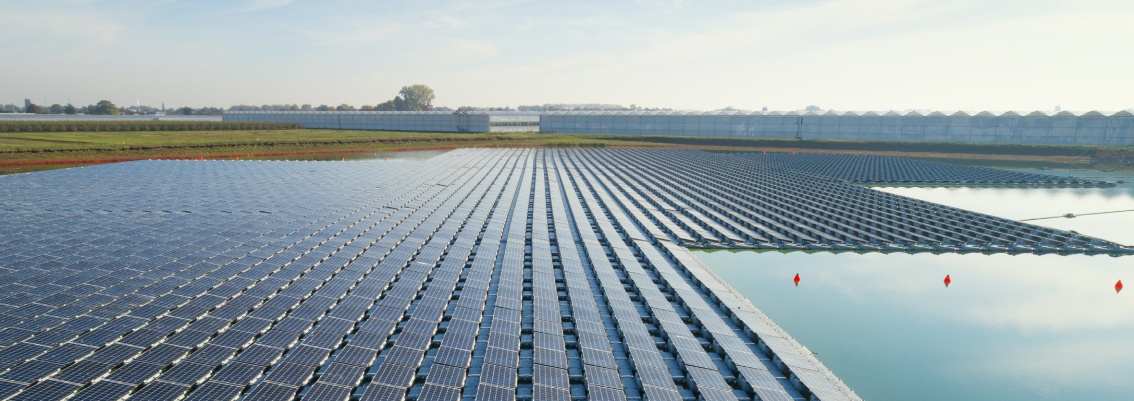DNV GL has launched a collaborative joint industry project with 14 industry participants to develop the industry’s first recommended practice for floating solar power projects. The planned recommended practice will provide a commonly recognised standard based on a list of technical requirements for developing safe, reliable and sustainable floating solar projects.
Floating solar power is a promising renewable energy technology in which solar panels are installed on floating structures on the surface of suitable bodies of water. The technology offers great potential for green energy production, particularly in areas where there is a shortage of available land for large photovoltaic plants.
The Floating Solar JIP consortium
The Floating Solar JIP consortium features a varied array of companies with extensive experience in the floating solar and related industries. Current members are:
- BayWa r.e. (Ger)
- Blue C Engineering (Ger)
- Carpi Tech/Makor Energy (Swi/Isr)
- Ciel & Terre International (Fra)
- Compagnie Nationale du Rhone (Fra)
- Noria Energy (US)
- EDF – Électricité de France (Fra)
- EDP – Energias de Portugal S.A. (Por)
- Equinor (Nor)
- Isigenere (Spa)
- Mainstream Renewable Power (UK)
- Scatec Solar (Nor)
- Seaflex (Swe)
- Statkraft (Nor)
Following the first projects in 2006, installed capacity for floating solar power was just 10 MW by 2015 but has accelerated considerably since then, reaching 3 GWpeak by the end of 2019. It is estimated that the total global potential capacity for deploying floating solar power on manmade, inland waters alone could be as high as 4 TW.
Despite this huge potential, there are as yet no harmonized standard approaches to developing floating solar power projects and no industry standards to ensure quality. This makes it difficult for investors, regulators and other stakeholders to have confidence in planned projects and to enforce relevant requirements, which could potentially put a break on the technology’s growth.
Responding to the industry’s need, DNV GL launched an initiative to develop a floating solar recommended practice via its industry-based, collaborative JIP (Joint Industry Project) approach. DNV GL has put together an international consortium of leading companies from the offshore, solar and floating structure manufacturing industries.
“As currently being the largest floating PV developer in Europe, BayWa r.e. is happy to be part of this consortium to develop this important guideline for the floating PV industry. We think establishing uniform high standards for Floating PV power plants will help to mature and enhance the Floating PV industry, therefore we are excited to bring in our extensive knowledge from the successfully realized Floating PV projects,” said Toni Weigl, Project Manager at BayWa r.e.
“Floating solar is a rapidly expanding technology with huge potential to help nations decarbonize, and one that we have been intimately involved with for many years. Drawing on our expertise in solar energy, floating wind, offshore platforms, Oil & Gas and Maritime technologies and industry knowledge, we have directly contributed to more than 1GW of floating solar projects, at different development stages. We are excited to work with so many committed industry leaders to create a recommended practice that will provide clear guidelines and requirements for safe, performing and long-lived floating solar projects,” added Prajeev Rasiah, Executive Vice President for DNV GL’s Energy business in Northern Europe, Middle East and Africa.
The JIP will look at all aspects of developing floating solar projects on inland and inshore waters. It will focus on five key topics: site conditions assessment, energy yield forecast, mooring & anchoring systems, floating structures, permitting and environmental impact.
By not limiting itself to any specific floating solar technology, the consortium aims to define requirements and guidelines that can be applied in practical manner to all floating solar projects.
Drawing on existing standards from related sectors, the consortium plans to develop a draft guideline document by the end of 2020. This will be made available for widespread industry consultation before the publication of the verified recommended practice, currently scheduled for Q1 2021.
“The results of the JIP will be a great enabler of floating solar going mainstream, by providing a set of guidelines that will accelerate the development of successful and safe floating solar projects. I encourage all the players in the value chain of the industry to use the recommended practice when it will be published,” added Andrés Franco, CEO of Isigenere.
Other companies with relevant expertise plus an interest and commitment to driving growth in floating solar are welcome to apply to join the consortium.

























